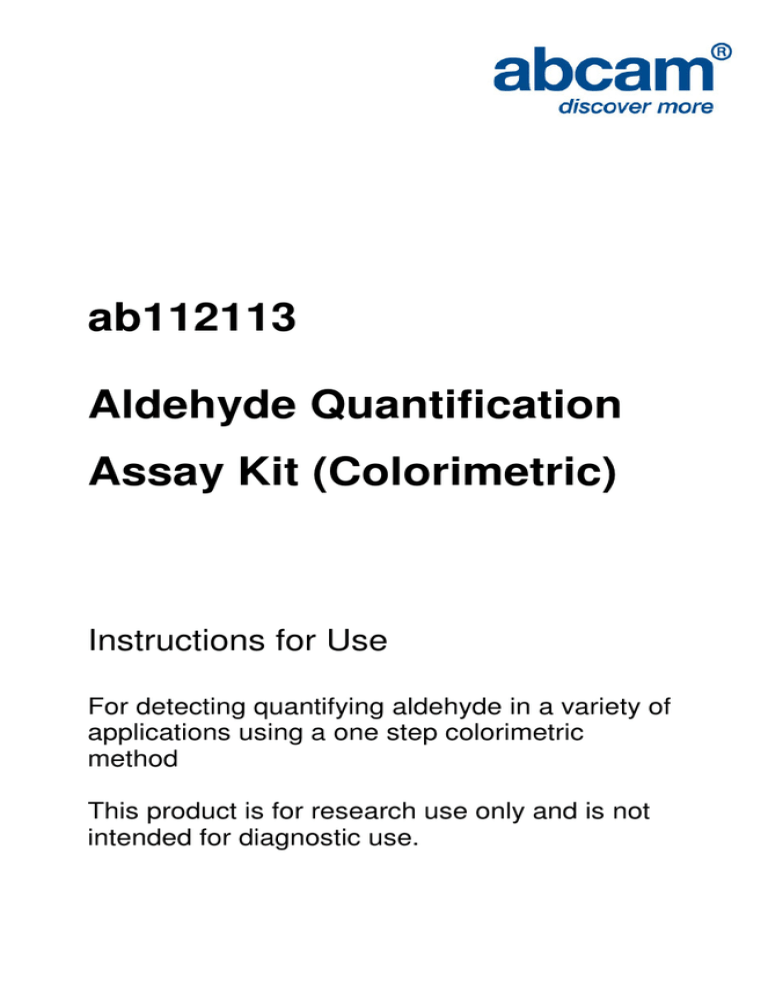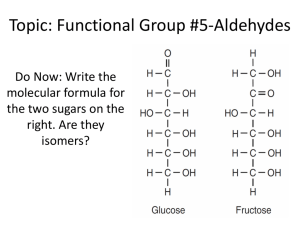
ab112113
Aldehyde Quantification
Assay Kit (Colorimetric)
Instructions for Use
For detecting quantifying aldehyde in a variety of
applications using a one step colorimetric
method
This product is for research use only and is not
intended for diagnostic use.
1
Table of Contents
1.
Introduction
3
2.
Protocol Summary
5
3.
Kit Contents
6
4.
Storage and Handling
6
5.
Assay Protocol
7
6.
Data Analysis
11
7.
Troubleshooting
13
2
1. Introduction
Very reactive aldehydes, namely 4-hydroxyalkenals, were first
shown to be formed in autoxidizing chemical systems. It was
subsequently
shown
that
4-hydroxyalkenals,
particularly
4-hydroxynonenal, were formed in substantial amounts under
biological conditions, i.e. during the peroxidation of lipids of liver
microsomes incubated in the NADPH-Fe system. Many other
aldehydes were also identified in peroxidizing liver microsomes or
hepatocytes, e.g., alkanals, alk-2-enals, and 4-hydroxyalkenals.
ab112113
Aldehyde
Quantitation
Kit
(Colorimetric)
uses
a
proprietary dye that generates a chromogenic product upon reacting
with an aldehyde. Most of the existing aldehyde test methods are
based on separations either by the tedious and expensive HPLC-MS
or GC-MS. ab112113 provides a sensitive, one-step colorimetric
method to detect as little as 1 nanomole of aldehyde in a 100 µL
assay volume (10 µM). The assay can be performed in a convenient
96-well or 384-well microtiter-plate format and readily adapted to
automation without a separation step. Its signal can be easily read
with an absorbance microplate reader at 405 or 550 nm. This kit has
been used for monitoring activities of oxidases that convert an amino
group to an aldehyde group.
3
Kit Key Features
•
Broad Application: Can be used for quantifying aldehydes
in a variety of applications such as carbohydrate, lipid
chemistry, as well as enzyme reactions.
•
Sensitive: Detect as low as 1 nanomole of aldehyde.
•
Continuous: Easily adapted to automation without a
separation step.
•
Convenient: Formulated to have minimal hands-on time. No
wash is required.
•
Non-Radioactive: No special requirements for waste
treatment.
4
2. Protocol Summary
Summary for One 96-well Plate
Prepare assay reaction mixture (50 µL)
Add 2X Yellow reaction mixture (50 µL)
Incubate at room temperature for 30-60 minutes
Monitor absorbance increase at 405 or 550 nm
Note: Thaw all the kit components to room temperature before
starting the experiment.
5
3. Kit Contents
Components
Amount
Component A: Yellow Indicator
2 x bottles
Component B: Assay Solution
1 x 10 mL
Component C: Aldehyde Standard
Component D: Dilution Buffer
1 vial
1 x 20 mL
4. Storage and Handling
Keep at -20°C. Avoid exposure to moisture and light.
6
5. Assay Protocol
Note: This protocol is for one 96 - well plate.
A. Prepare 2X Yellow Reaction Mixture
Add 5 mL of Assay Solution (Component B) into the bottle of
Yellow Indicator (Component A), and mix well.
Note 1: 5 mL of the 2X Yellow reaction mixture is enough for
1 plate. The reaction mixture is not stable. Use within
2 hours.
Note 2: Assay solution (Component B) is potentially
hazardous. Wear gloves when handling it.
B. Prepare serial dilutions of Aldehyde Standard
1. Add 1 mL of Dilution Buffer (Component D) into the vial
of Aldehyde Standard (Component C) to make a 10 mM
aldehyde standard stock solution.
Note: The unused 10 mM Aldehyde standard stock
solution should be divided into single use aliquots and
stored at -20 °C.
7
2. Take 100 µL of 10 mM aldehyde standard stock solution
(from Step 1) to perform 1:10, and 1:3 serial dilutions to
get 1000, 300, 100, 30, 10, 3, 1, 0.3, and 0 µM serial
dilutions of aldehyde standard.
3. Add serial dilutions of aldehyde standard and aldehydecontaining test samples into a 96-well white/clear bottom
microplate as described in Tables 1 and 2.
Note 1: Both BSA and Tween 20 will interfere the assay,
use less than 0.001% BSA and 0.01% Tween 20 in the
samples.
Note 2: If the aldehyde-containing samples are from the
enzyme reaction such as fructose-1,6-bisphosphate with
fructose-1,6-bisphosphate aldolase, prepare 50 µL of
enzyme reaction (25 µL for a 384-well plate) as desired.
Incubate the enzyme reaction at 37°C for at least 1 hour.
The
components
of
enzyme
reaction
should
be
optimized as needed (e.g. an optimized buffer system
might be required for a specific enzyme reaction).
Note 3: In most cases, Dilution Buffer (Component D)
can also be used for running enzyme reaction if you do
not have an optimized enzyme buffer.
8
BL
BL
TS
TS
AS1
AS1
....
....
AS2
AS2
....
....
AS3
AS3
AS4
AS4
AS5
AS5
AS6
AS6
AS7
AS7
Table 1. Layout of Aldehyde standards and test samples in
a white/clear 96-well microplate.
Note: AS= Aldehyde Standards, BL=Blank Control, TS=Test
Samples.
Aldehyde Standard
Blank Control
Test Sample
Serial dilutions*: 50 µL
Assay buffer: 50 µL
50 µL
Table 2. Reagent composition for each well.
*Note: Add the serially diluted calcium standards from
0.3 µM to 1000 µM into wells from AS1 to AS7 in duplicate.
9
C. Run Aldehyde Assay:
1. Add 50 µL of 2X Yellow reaction mixture (from Step A)
into each well of the aldehyde standard, blank control,
and test samples (see Step 3) to make the total
aldehyde assay volume of 100 µL/well.
Note: For a 384-well plate, add 25 µL of sample and
25 µL of aldehyde reaction mixture into each well.
2. Incubate the reaction mixture at room temperature for
30 to 60 minutes, protected from light.
3. Monitor the absorbance increase with an absorbance
plate reader at 405 or 550 nm.
Note: Different concentrations of the aldehyde might
form different colors with Yellow Indicator. At lower
concentration, the absorbance at 405 nm gives the best
result. However, at higher concentration, the absorbance
tends to shift to 550 nm.
10
6. Data Analysis
The absorbance in blank wells (with 0 aldehyde standards and 2X
Yellow reaction mixture only) is used as a control, and is subtracted
from the values for those wells with the aldehyde reactions. An
aldehyde standard curve is shown in Figure 1.
Note: The absorbance background increases with time, thus it is
important to subtract the absorbance intensity value of the blank
wells for each data point.
Figure 1. Aldehyde dose response was measured in a 96-well black
plate with ab112113 using a microplate reader. As low as 10 µM
(1 nmol/well) of aldehyde can be detected with 30 minutes
incubation (n=3). Standard curve read at 405 nm.
11
Figure 2. Aldehyde Spectrum. The absorbance spectrum of
glyceraldehyde, after aldehyde reaction with Yellow Indicator. The
squares represent buffer only. The circles represent
glyceraldehdyde. The spectrum shape doesn't change with
concentration, but the intensities
ies (at both 405 nm and 550 nm)
increase with glyceraldehdyde concentration.
12
7. Troubleshooting
Problem
Reason
Solution
Assay not
working
Assay buffer at
wrong temperature
Assay buffer must not be chilled
- needs to be at RT
Protocol step missed
Plate read at
incorrect wavelength
Unsuitable microtiter
plate for assay
Unexpected
results
Re-read and follow the protocol
exactly
Ensure you are using
appropriate reader and filter
settings (refer to datasheet)
Fluorescence: Black plates
(clear bottoms);
Luminescence: White plates;
Colorimetry: Clear plates.
If critical, datasheet will indicate
whether to use flat- or U-shaped
wells
Measured at wrong
wavelength
Use appropriate reader and filter
settings described in datasheet
Samples contain
impeding substances
Unsuitable sample
type
Sample readings are
outside linear range
Troubleshoot and also consider
deproteinizing samples
Use recommended samples
types as listed on the datasheet
Concentrate/ dilute samples to
be in linear range
13
Problem
Reason
Solution
Samples
with
inconsistent
readings
Unsuitable sample
type
Refer to datasheet for details
about incompatible samples
Use the assay buffer provided
(or refer to datasheet for
instructions)
Use the 10kDa spin column
(ab93349) or Deproteinizing
sample preparation kit
(ab93299)
Increase sonication time/
number of strokes with the
Dounce homogenizer
Aliquot samples to reduce the
number of freeze-thaw cycles
Troubleshoot and also consider
deproteinizing samples
Use freshly made samples and
store at recommended
temperature until use
Wait for components to thaw
completely and gently mix prior
use
Always check expiry date and
store kit components as
recommended on the datasheet
Samples prepared in
the wrong buffer
Samples not
deproteinized (if
indicated on
datasheet)
Cell/ tissue samples
not sufficiently
homogenized
Too many freezethaw cycles
Samples contain
impeding substances
Samples are too old
or incorrectly stored
Lower/
Higher
readings in
samples
and
standards
Not fully thawed kit
components
Out-of-date kit or
incorrectly stored
reagents
Reagents sitting for
extended periods on
ice
Incorrect incubation
time/ temperature
Incorrect amounts
used
Try to prepare a fresh reaction
mix prior to each use
Refer to datasheet for
recommended incubation time
and/ or temperature
Check pipette is calibrated
correctly (always use smallest
volume pipette that can pipette
entire volume)
14
Problem
Reason
Solution
Standard
curve is not
linear
Not fully thawed kit
components
Wait for components to thaw
completely and gently mix prior
use
Pipetting errors when
setting up the
standard curve
Incorrect pipetting
when preparing the
reaction mix
Air bubbles in wells
Concentration of
standard stock
incorrect
Errors in standard
curve calculations
Use of other
reagents than those
provided with the kit
Try not to pipette too small
volumes
Always prepare a master mix
Air bubbles will interfere with
readings; try to avoid producing
air bubbles and always remove
bubbles prior to reading plates
Recheck datasheet for
recommended concentrations of
standard stocks
Refer to datasheet and re-check
the calculations
Use fresh components from the
same kit
For further technical questions please do not hesitate to
contact us by email (technical@abcam.com) or phone (select
“contact us” on www.abcam.com for the phone number for
your region).
15
16
17
18
UK, EU and ROW
Email: technical@abcam.com
Tel: +44 (0)1223 696000
www.abcam.com
US, Canada and Latin America
Email: us.technical@abcam.com
Tel: 888-77-ABCAM (22226)
www.abcam.com
China and Asia Pacific
Email: hk.technical@abcam.com
Tel: 108008523689 (中國聯通)
www.abcam.cn
Japan
Email: technical@abcam.co.jp
Tel: +81-(0)3-6231-0940
www.abcam.co.jp
19
Copyright © 2012 Abcam, All Rights Reserved. The Abcam logo is a registered trademark.
All information / detail is correct at time of going to print.


